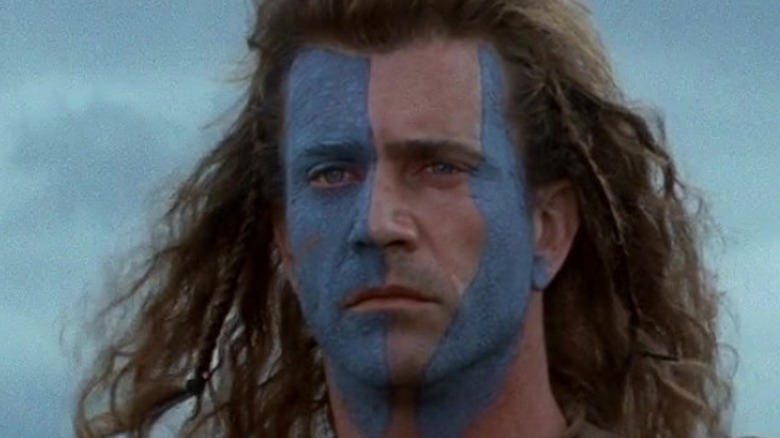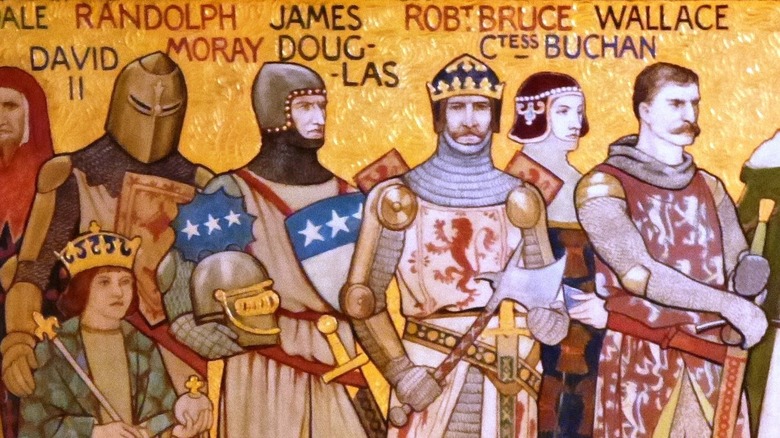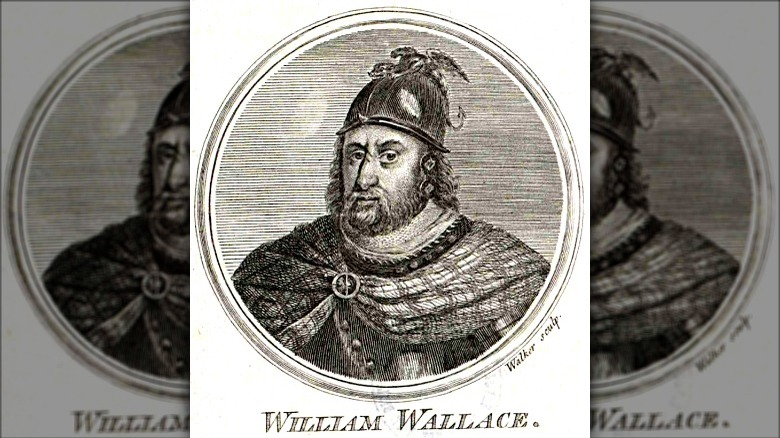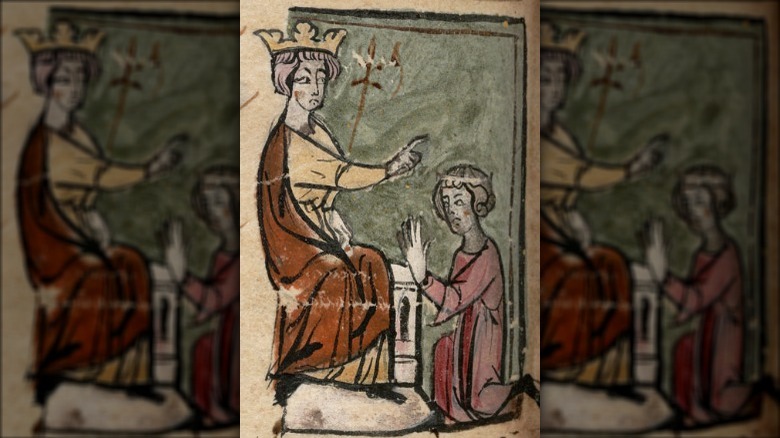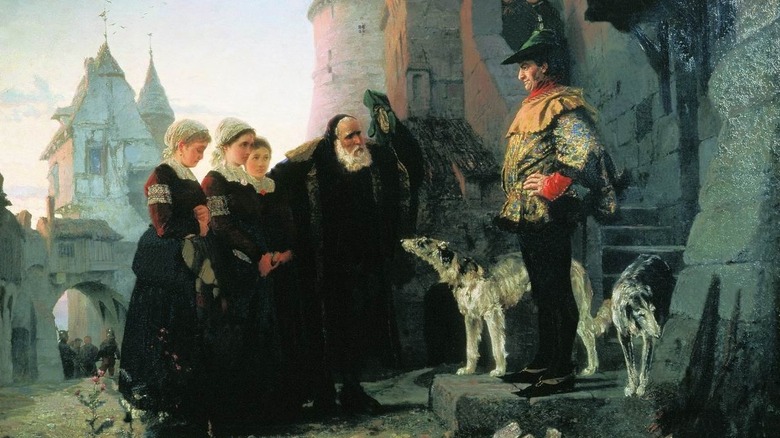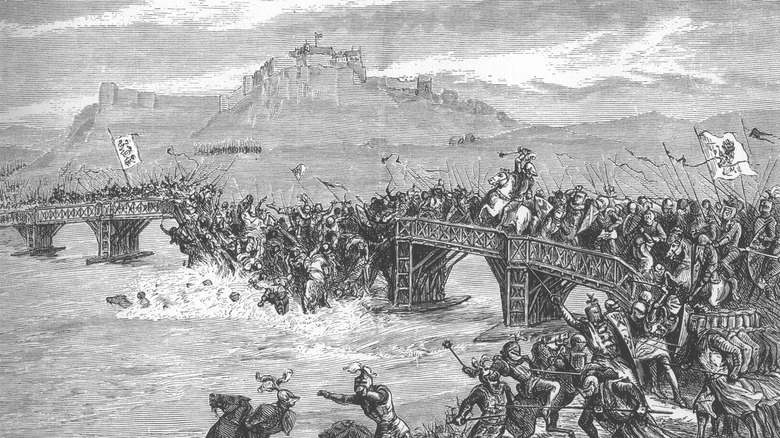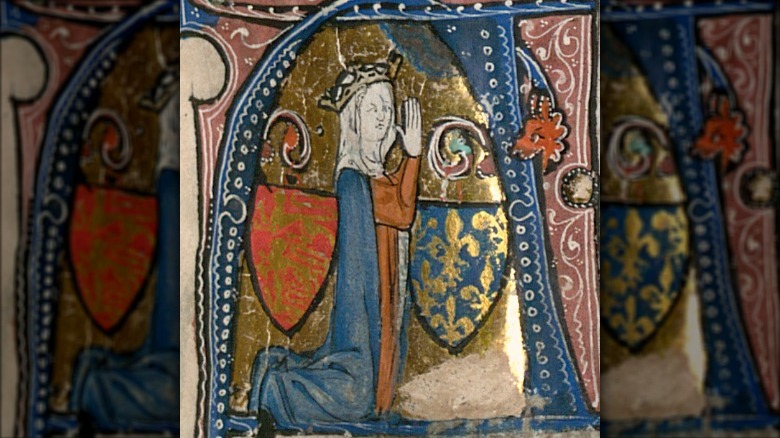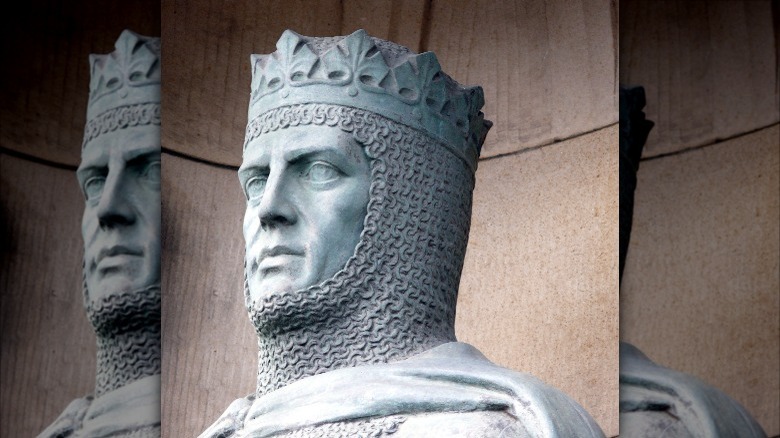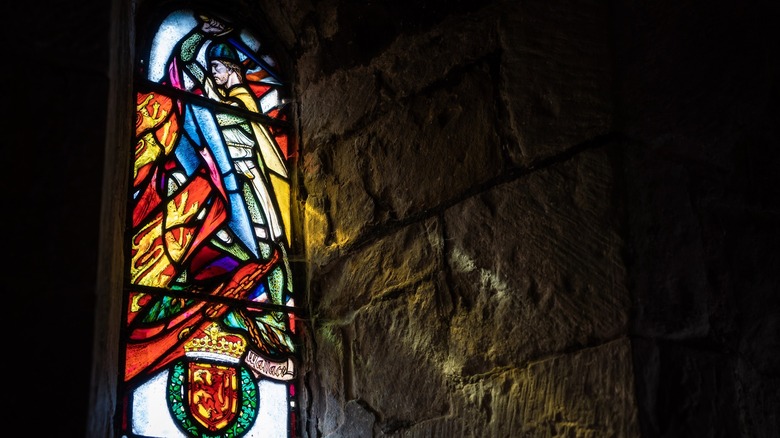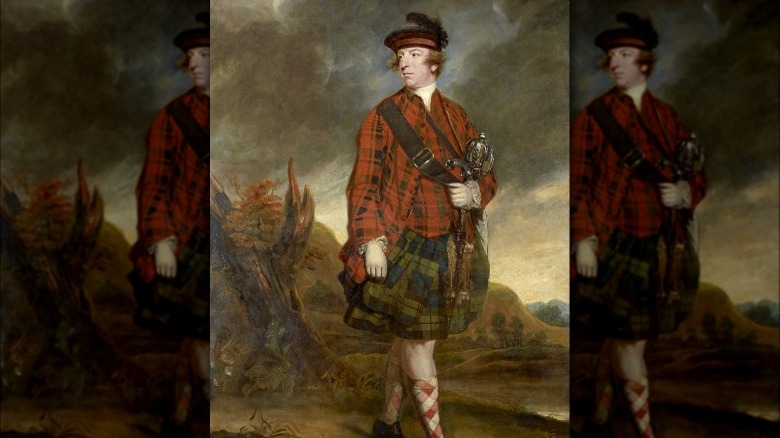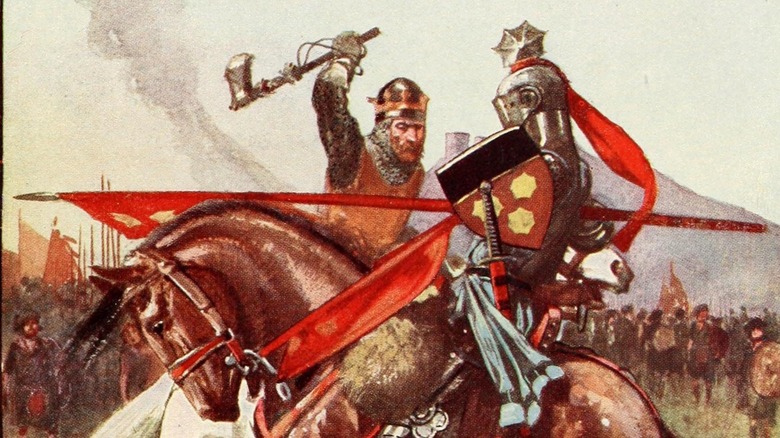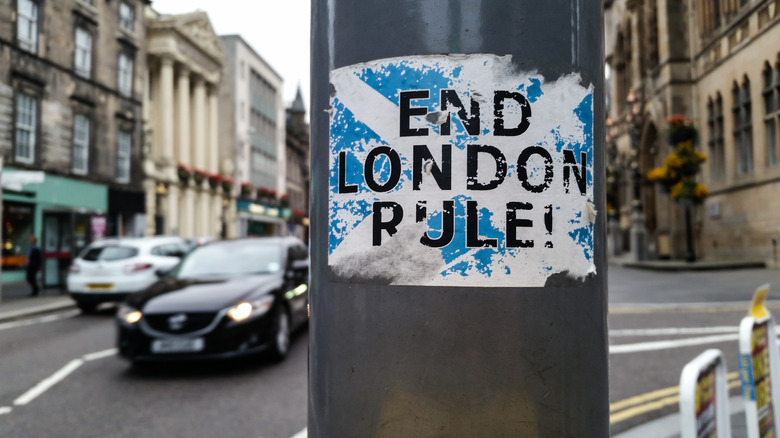The True Story Behind Braveheart
It's probably fair to say that few, if any, of us really think that "Braveheart" is a historically-accurate film. Sure, it wowed audiences when it premiered in 1995 and it certainly garnered actor and director Mel Gibson some shiny Academy Awards for Best Picture and Best Director. But, as darn near any historian or Scottish person will tell you, the movie tale of William Wallace, medieval Scottish rebel and perpetual shouter of the phrase "Freedom!" while wearing blue face paint, isn't true to life.
Now, to be fair, there are hints of the real story throughout Gibson's movie. Most of the main characters, including William Wallace and central baddie King Edward I, really existed. And it's true that England was starting to make incursions into Scotland in the 13th century, making trouble in what eventually became known as the first of the Scottish wars of independence (via BBC).
But was Edward I really that cartoonishly evil? Was Wallace actually a scrappy peasant? And how could he have had an affair with a beautiful foreign princess, anyway? If you're ready to step away from Hollywood and closer to reality, here's your chance. This is the true story behind Braveheart.
The struggle for Scotland's independence was very real
The state of 13th century Scotland was indeed precarious, and a succession crisis certainly didn't help. According to the BBC, Alexander III had been king of Scotland since 1249. However, upon traveling to collect his new wife from Fife, Scotland in 1286, Alexander appears to have fallen from his horse and died. His unborn heir died, as did the next in line, Alexander's granddaughter Margaret, just a few years later. Without a clear successor to the Scottish throne, a power vacuum developed. And then England stepped in.
Well, not after being sort-of invited first. The BBC reports that Edward I of England was asked to mediate between the two top contenders for king, John Balliol and Robert the Bruce's grandfather. Balliol, who agreed to pay fealty to Edward, got three years on the throne before being shuffled aside in favor of a council. Said council then started to push back against England and allied itself with France (via World History Encyclopedia). Edward used this as an excuse to invade in 1296, seizing Scottish lands and temporarily throwing Balliol into the Tower of London.
This was the effectively the beginning of the medieval English incursion into Scotland. Yet "Braveheart" claims that the English have been lording it over Scots for years at the beginning of the film, a claim that's patently untrue.
William Wallace wasn't a scruffy peasant
In the 1995 film, William Wallace is presented as a hearty peasant traipsing about the Scottish Highlands. Sure, he's been taken on a bit of a European vacation by his uncle Argyle — who wasn't real, says The Scotsman, as much as you might want to believe that actor Brian Cox was traveling about medieval Scotland. And the not-quite-true Argyle does give the young boy an education before he returns to the homeland, setting the adult Wallace somewhat apart from his peers. But, surely, old William was a homespun man of the people, right?
Only, that's Sir William Wallace to you. Turns out he was actually a minor member of the gentry, not an unwashed ruffian. His dad was a knight and Wallace himself would become a member of the country's ruling council and a "Guardian of Scotland" in charge of the nation's armies. According to the World History Encyclopedia, later sources tried to frame him as a commoner in an attempt to popularize his story and make him a rebellious folk hero.
That said, he was one of the most prominent people to rebel against Edward's incursions onto Scottish soil. By March 1296, the English king had captured Berwick, stolen the Scottish coronation stone, and installed English governors over the land. Wallace first began leading raids against the English the next year, with the high point coming at the Battle of Stirling Bridge in September 1297.
English treatment of Scottish rebels was harsh
Though the film necessarily dramatizes the way that English overlords and Edward I himself treated the Scottish, it is true that those who rebelled or were in the way were often put down brutally, as in the 1296 Sack of Berwick (via BBC). Take the story of what happened to Robert the Bruce's relatives. As Historic UK reports, the Bruce family went their separate ways after the 1306 Battle of Dalry. The idea was that Robert, being one of the prime offenders against the English crown, wouldn't bring down punishment on his less active relatives, namely noncombatant women.
Only, the English didn't see it that way. They soon captured the women, which included Robert's wife Elizabeth de Burgh, his 12-year-old daughter Marjorie, and sisters Christina and Mary. Elizabeth got off pretty easily (perhaps because her marriage had been arranged by Edward I himself) and was stuck with house arrest. Marjorie was initially threatened with time spent in a cage dangling from the Tower of London, but was eventually sent to a convent for the duration. So, too, was Christina.
The worst punishment seems to have been reserved for Mary, who was reportedly imprisoned in a tiny cage at Roxburgh Castle. Isabella MacDuff, a noble who had crowned Robert king, received similar brutal treatment.
Edward II and his father were very different people
Though quite a lot of "Braveheart" focuses on William Wallace's story, it also touches on the relationships of the other characters like Edward I's son and heir, the future Edward II. But where Edward I is depicted as a cold-hearted ruler, his son is shown as a weaker, less disciplined man.
Yet, while Edward I could be ruthless, he probably wasn't cinematically villainous. Medievalists.net notes that he was an uncompromising military man who had already conquered Wales before the whole Scotland affair got going. Yet, he was also apparently a loving husband, going so far as to build a series of crosses in memory of his beloved wife, Eleanor. And, no, there's no evidence that he tossed his son's male lover out of a window.
Edward II is perhaps best remembered for allegedly having relationships with male favorites, namely Piers Gaveston and Hugh Despenser (via English Heritage). He proved to be an unpopular and ineffectual king, especially after losing a key battle to Robert the Bruce. Per the World History Encyclopedia, Edward I died in 1307. The inexperienced Edward II's lack of interest in making war allowed Bruce to begin his takeover, culminating with Edward's humiliating defeat at the 1314 Battle of Bannockburn and the loss of English control over Scotland. He would spend the rest of his reign as a beleaguered, unloved king.
Primae noctis probably wasn't a thing
One of the examples of English lords brutally wielding power over the Scottish common folk in "Braveheart" is the chilling practice of jus primae noctis, or "right of the first night." Also known as droit du seigneur ("the lord's right"), it supposedly meant that the local lord could swoop in on a wedding celebration and claim the bride for her "first night," rather than her newly-minted husband. It happens to an unnamed couple on screen, and Wallace married his lover Murron in secret to prevent just such an atrocity happening to her, too.
Yet, there are practically no records of medieval lords exercising this "right." We can't be absolutely certain that it never happened, to be fair. Yet, Britannica notes that this may have just been another form of taxation in a purely financial sense, while even people who kind-of, sort-of believe in the idea admit that the evidence is pretty circumstantial and could be based on later confabulations (via The Journal of Sex Research).
Certainly, if Wallace were to have married (and there's actually no record that he ever made a match with anyone at all, per The Times), his wife would have been relatively "safe." That is, he was already a noble and wouldn't have been of the peasant class that was supposedly subject to this tradition.
The Battle of Stirling Bridge happened - but without the blue face paint
"Braveheart" rightfully depicts the Battle of Stirling Bridge as a major win for Wallace and the Scots — even though the titular bridge doesn't appear on screen. Per the BBC, this 1297 battle took place mere months after William Wallace and his associates began to fight back against the English. At Stirling Castle, English forces led by John de Warenne met with Wallace's army. Diplomatic talks stalled out and Warenne decided to push across the bridge to the rest of Scotland.
In the ensuing battle, the Scots used the narrow landscape to entrap the soldiers. Warenne eventually demolished the bridge, retreating and leaving half of his forces stranded with the Scots. Thousands of English were killed, the occupation was dealt a devastating blow, and Wallace gained enough clout that he was named Guardian of Scotland. Wallace later led parties into northern England, reportedly burning over 700 villages to the ground (though he never made it as far south as York, as the film claims).
And, no, they almost certainly didn't win their victory while slathered in blue face paint. That's actually a callback to the Picts, an ancient people who lived in Scotland thousands of years ago and very definitely before Wallace's time. Also known as the "Painted People" for their distinctive look during battle as well as their tattoos, the Picts busied themselves fighting back against Roman occupiers (via Live Science).
Isabella of France never met Wallace
In "Braveheart," Isabella of France, the newly-minted wife of Edward II, is sent to negotiate with Wallace. She's actually meant as a distraction technique, keeping Wallace's attention far away while the villainous Edward I (who we presume was twirling a comically large mustache at this point) lands English soldiers elsewhere in Scotland.
However, Isabella's role is one of the biggest inaccuracies in the entire film. For one, there's the rather obvious fact that Isabella would have been about nine years old when Wallace died in 1305. In fact, according to History Extra, she wasn't even officially linked to the English royal family at that time. The 12-year-old Isabella wouldn't marry the 23-year-old Edward II until 1308, nearly three years after Wallace was executed. She certainly wouldn't have been in the country, much less be of an age where she could negotiate terms or carry on a torrid love affair with the Scottish rebel, as "Braveheart" really, really wants you to believe.
What's more, the film really does Isabella a disservice by making her a typically swooning love interest. In fact, she was a strong-willed and powerful ruler after the abdication and death of Edward II, to the point where she became known as the "she-wolf of France." Her bold moves and attempts to rule England as her young son and future king grew up set her apart as a singular medieval woman. Maybe they should have made a movie about her instead.
Robert the Bruce and his family didn't exactly betray Wallace
Though Wallace enjoyed great success at the 1297 Battle of Stirling Bridge, things wouldn't stay that way. According to the World History Encyclopedia, he suffered a pretty embarrassing defeat the next year at the Battle of Falkirk. Wallace resigned his post as Guardian of Scotland and then disappears from the historic record. He may have made his way to France and begun negotiating support for Scotland there, or he could have been hiding out in the remote Highlands. Some speculate that he even went to Rome and had an audience with the pope.
We do know, however, that Wallace was apprehended in Glasgow by the English in August 1305. Medieval writers blamed treacherous Scots, while "Braveheart" places the blame squarely on the Bruce family shoulders.
Though Robert the Bruce did occasionally play nice with the English for political purposes, it eventually became clear that his ultimate goal was an independent Scotland (with himself on the throne, of course). While Wallace disappeared, we know that Bruce began negotiating with the English. Yet, as Smithsonian Magazine points out, there's no evidence that he directly betrayed Wallace. Someone might have, but historians can't be sure that it wasn't someone else entirely.
William Wallace did face a brutal execution
While quite a few details of "Braveheart" are either difficult to prove or even outright falsehoods, we can be pretty sure that William Wallace suffered a bloody end at the hands of the English. In fact, the 1995 film, with its careful framing and editing, actually pulls back from the true brutality of what was done to Wallace on his final day.
According to "The Myth of William Wallace," Wallace was specifically accused of sedition. For that charge, he was taken from Glasgow, where he was apprehended, to the Tower of London. He faced what was surely one of the worst ways to die in medieval Europe: hanging, drawing, and quartering. Wallace was first stripped nude and dragged through the streets on a hurdle. He was then "hanged," which really mean that he was painfully strangled until nearly dead. Then his privates were cut off, he was disembowelled, and finally beheaded.
Now, with Wallace mercifully dead, his remains were cut into four quarters. Per History Extra, his disassembled body parts were then displayed across England, with his head prominently placed on a spike on London Bridge. That done, Wallace arguably became a Scottish martyr and certainly would become a nigh-on mythical figure in his nation's history.
Those tartans have a complicated history
Surely, one of the key details about "Braveheart" and the way Scottish history and culture is depicted therein can be summed up by the tartan. After all, a tartan can represent not just Scotland overall, but individual clans and the freedom-loving Scottish spirit. That must be why a tartan-clad, kilt-wearing Mel Gibson featured so prominently on all the marketing materials, right?
Not exactly. Though it seems like an entrenched part of Scottish culture today, the idea of tartans that were assigned to different clans didn't really start until the early 19th century or, if you really stretch the definition, the mid-18th century (via Collector's Weekly). In 1739, Highland soldiers were organized in the British army by region, with regiments given specific tartans. But it would be nearly 100 years before clan tartans became a thing, helped along by weavers looking to make a profit and sketchy historians who weren't above making up their sources.
However, if all of this is bumming you out, you can take heart in knowing that tartan patterns and kilts were definitely an established thing eventually, though not really until after Wallace's time, says Historic UK. Kilts weren't exactly popular wear for nobles, all of this meaning that Wallace and his fellows almost certainly wouldn't have worn them. If nothing else, nobles in kilts were more of a 19th century fashion affectation, according to the Metropolitan Museum of Art.
The Battle of Bannockburn was a major turning point
At the finale of "Braveheart," William Wallace is dead and gone, but his spirit lives on to inspire the Scottish people in their fight for freedom. Robert the Bruce, now king of Scotland, draws upon Wallace's image and he leads soldiers to victory at the Battle of Bannockburn.
However, there are some key differences between how the battle is portrayed on screen and how it actually went down. For starters, it took place in 1314, nearly a decade after Wallace's death, according to the BBC. That's quite a long time for someone's legacy to inspire such passionate action, though the plethora of Wallace monuments throughout Scotland may indicate otherwise. Yet, we have no record of Robert invoking a years-dead compatriot before the battle in an inspiring speech.
It is true that Bannockburn was a major win for the Scottish. At this point, says Britannica, Edward II was king of England. He'd done a pretty poor job of living up to his dad's conquering legacy, given that all he had left in Scotland at this point was Stirling Castle. Not unlike the Battle of Stirling Bridge, Robert's forces used the landscape to create choke points for English forces, killing thousands of enemy soldiers and helping the Scots to win the day. This marked a key point in the move towards full Scottish independence, though it would take until 1328 for the Treaty of Northampton to officially recognize the split.
Scotland's independence cause didn't end there
"Braveheart" doesn't exactly pretend that the medieval war for independence was the only step in establishing a separate Scottish kingdom. Yet, neither does it take the time to outline much of what happened after Wallace's death. Then again, given the long, complicated, and intertwined history of Scotland and England, the run time of the film would have become agonizingly bloated.
Still, though, it's worth noting that things weren't exactly tied up with a neat little bow after Robert the Bruce and his forces prevailed at the Battle of Bannockburn. Robert the Bruce went on to reign as an independent king, though the split wasn't officially recognized until 1328. According to Smithsonian Magazine, there was even a Second War of Independence later in the century, though that eventually faded into the background as the English butted heads with France in the Hundred Years' War.
Ultimately, the two crowns were effectively merged when James VI of Scotland became James I of England after the English monarch, Elizabeth I, died in 1603. This circumstance, known as the Union of the Crowns, meant that both nations had the same monarch (via UK Parliament). The kingdoms were officially made part of the larger United Kingdom with the 1707 Act of Union (via Britannica). But things are never quite done, reports Smithsonian Magazine, as Scottish nationalists have continued to agitate for independence well into the modern day.
